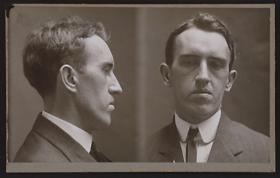Artifacts
Bertillon cards
In 1879, Paris police clerk Alphonse Bertillon devised a system of anthropometry ("the measurement of man") that could be used to identify people held in police custody, based on fourteen identical measurements, a standardized photographic portrait (frontal and profile), the classification of facial and bodily characteristics, and the notation of scars and tattoos. These were recorded on cards that were filed according to a complex method, so that they could be matched and retrieved. Bertillon's system (called anthropometry, bertillonage, or signaletics) was adopted by police departments and correction systems in many jurisdictions in Europe and the Americas. These cards were collected by the New York City Police Department in the early 20th century.
